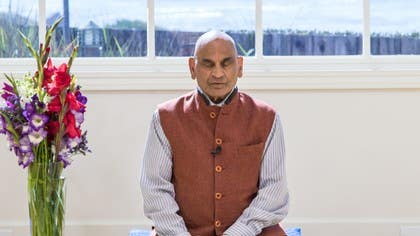Description
About This Video
Transcript
Read Full Transcript
Nice to see you, and Raviji, thank you for joining us to talk about your translation of the Sutras. We actually first met in 2008 when you were doing a course that led to this translation, so that was a fortunate day for me. Well, fortunate for me also to make friendship with you. So in your understanding, and I know this is sort of a big question, but what's the primary thrust of the Sutras? What is Patanjali hoping to help us understand or grok?
Well, really several things are actually common to all spiritual teachings, and the yoga Sutras is one of the very transformational teachings. The fundamental idea really is that as long as I remain the way I am, I cannot come to the truth, or God, or any other expression one wishes to use for this. We can see this in the Gospels, for example, in fact so much transformation is needed is like a whole new birth Christ speaks about, similarly here. But what is the overall nature of that transformation is really freedom from myself. It's ironic that we often think in terms of freedom for myself, all spiritual teachings, certainly the yoga Sutras, all the Bhagavad Gita, all the Gospels, are really actually speaking about freedom from myself.
So that what is really true can be heard, can be seen, but it is a way of expressing it, can be experienced. So part of what keeps us occupied with me, me, me in practice is the ordinary mind. Always thinking of the past or the future, or somewhere else but not here. So very strong emphasis, particularly in the yoga Sutras, even more so than most places, on the quietening of the mind. In fact the very first substantial Sutra, which is in the first chapter, second Sutra, dha chitta bhriti nirodha, yoga is stopping all the movements of the mind.
Because the idea is a very strong one, that there are levels of reality subtler than the mind, and that the mind is not the real knower, but it can become an instrument of knowledge, just as a microscope is not the knower, but it can be an instrument of knowing, and then one can have a bad microscope or a good microscope. Similarly, there is very strong suggestion that the mind needs to be refined, cleansed. In fact to use Padanjali's own expression, then it can be like a pure diamond. Whatever it is placed on, it just allows the object to be revealed rather than introducing its own coloration. And so that is the direction.
But there is a little bit more, if you like, any serious philosophical expression about highest reality of necessity has to be, if you like, by negation. It can't say, for example, the Buddha refused to say what is nirvana, but it can say what it is not. Similarly, Padanjali, in the first chapter particularly of the Yoga Sutras, doesn't really describe what that state will be of stillness, but that it is free of mental activity, as a briti. But in the second chapter, there is a slightly different, if you like, seemingly more positive way of describing what is yoga about. This is actually the second sutra, in the second chapter, that yoga is for the purpose of cultivating Samadhi and diminishing the clashers.
Now the clashers are all what stands in our way, impediments, resistance. And Samadhi, rather interesting in a way, again coming back to what I initially said, he is described by Padanjali in the third sutra of the third chapter, as Swarupasunya, where I am not. You see, that whole idea, freedom from myself, so that only the object, whatever I am actually looking at or bringing my attention to, only that is there. So anything, any words we use have to be understood really a little bit with kind of a freedom rather than rigidly. It will be something like seeing without the seer.
As if I am not, I am not the one seeing it, but seeing is taking place. Krishnamurti often spoke words like this, and it can be puzzling in a way, but the idea really is that I am out of the way, and perception is taking place. I meaning my usual mental activities, my likes or dislikes. For example, when he describes the clashers, what stands in our way, the very first one is asmita, which is, it literally means I am this or I am that, which already limits my connection with the whole reservoir of being. So if I say I am a professor, but I am also a father, I am also a son, a lover, a consumer, I am many other things.
So to identify myself with one thing limits my identity. Then I forget that ultimately, certainly all the sages in India would say that ultimately I am connected with Brahma, I am Brahma. That is not so easily said, because any damn fool, even me, can repeat these words. But that's not what makes it true. So how does my behaviour display this?
So that's the very first objection. But I should here say that he repeatedly says, very strongly in the second chapter, that the root cause of all this is avidya, ignorance. This is everywhere, in fact I don't personally know any sage in India or any scripture, for example, well, the US sutras or the Bhagavad Gita or any of the Upanishads, which would say otherwise. They all say that the root cause of all our problems is avidya, meaning ignorance. But mainly the ignorance of our true nature.
We imagine we are something which we are not, and we don't realize what we truly are. And then among the various kleshas or impediments, I mention Asmita, Raghu Dvesh, which is like dislike, I like this or I don't like this. But these are all arising out of ignorance. And actually another one is maybe good to say that, Abhinivesh. Now here is an example, by the way, why different translations need to, each one has its own shtick.
I like this American expression, every translator has his own shtick. If somehow you are convinced, which is a streak in Indian spirituality, that living in this world is a bad idea. One should be free of this world. Then they would translate Abhinivesh as a wish to continue living. You could read some of the translations, you'll find this, as if there is something wrong with the wish to continue living.
Abhinivesh really literally is the momentum of whatever state I am in. I wish to continue that. We have a principle like this in physics, first law of motion of Newton, actually is exactly that. A body at rest remains at rest, a body in linear motion, continues to be in linear motion unless it is stopped by some external force. Here Patanjali is more speaking psychologically rather than physically.
And I personally think Abhinivesh is like addiction to the status quo. Whatever the status quo could even be miserable. But somehow we continue this or people don't like their job, then they resign, soon they end up getting a very similar job or they want to get out of their marriages, soon they end up marrying a person, more or less a similar thing. So we repeat this very strongly. So there are these various impediments or difficulties that stand in our way, but Patanjali is very clear, repeatedly says this, that the root cause of all of this is avidya, ignorance.
And what are some of the primary tools or qualities or suggestions from Patanjali on how we can begin to effectively work with ourselves? Well, again, there are four or five words in Sanskrit, but it's useful to have them. One is, this is, two words are much more emphasized in the first chapter, three words much more emphasized in the second chapter, ironically. So let me just mention them. In the first chapter, very strong emphasis on abhyas and vairagya.
Abhyas is really like practice, to stay with something, even if you're not getting the result that you thought right away, but to come back to it again and again. Practice, steadiness or staying with some project that's very strongly emphasized by Patanjali. Krishna in the Bhagavad Gita repeats these words, so it's clearly understood to be important. And vairagya is really like a detachment or non-identification with whatever one sees. But there, Patanjali is very clear, there are two kinds of vairagya's.
One is what he calls lower vairagya. I see that the world is being driven by fear and ambition. I don't like it, so I move away from it. So you see, it's moving away from something that you don't find leading to truth or reality. But then he says, higher vairagya arises from a vision of the transcendent being.
Once you have seen something real, then you cannot not keep coming back to it. You miss it. Actually, a great deal of poetry, particularly in Sufi poetry, or Krishna related poetry in India, or John of the Cross, actually, very much, he speaks about the dark night of the soul. Something real has been seen or experienced, then I miss it very much. So then I'm not interested in other things.
So that vairagya, which is, if you like, indifference to other things, arises, he says, higher vairagya arises from having seen something real. Lower vairagya is a kind of going by repulsion. I don't like it. This is not real. But he very much emphasizes vairagya.
We have a classical, actually, classical text of Christian spirituality, cloud of unknowing, which speaks about that everything you know, put it below the cloud of forgetting. There will be another way of saying, vairagya, because God is on the other side of the cloud of unknowing. Only love can come. There are not any knowledge, et cetera. Very interesting.
I was actually invited in England to give a talk on Patanjali's Yoga Sutra and the cloud of unknowing. Cloud of unknowing constantly speaks about love. Patanjali doesn't even use the word love. But fundamentally, they are speaking about exactly the same thing. So that was actually my talk about this.
Because strictly speaking, you cannot have vairagya for everything you see unless you are in love with something that you have either once seen or at least you have some, something draws you to that. So actually, at the heart of indifference to everything you see is love for something else. It's a very interesting person. At least it's worth considering that. And so Patanjali very much emphasizes these two words and therefore corresponding ideas.
In the first chapter, abhyas and vairagya. But in the next chapter, and it's even repeated in the third chapter, three things, which is really the very first sutra in the second chapter he speaks about, tapas, swadhyay and ishwar pranidhana. These three practices, tapas really simply means effort. Literally, it actually means temperature. But any effort creates some heat, if you like.
And so effort would be more or less, okay, translation. Although again, as I have often said, that every translation is a transcreation, sometimes you would find the translation of tapas as austerity. Which is not entirely wrong, but one needs to understand that every effort is a kind of austerity in a certain way. So I don't need to say very much about it. But swadhyay may be useful to mention, literally it means self-study.
But other words in English would be quite relevant, self-knowledge, self-inquiry, self-observation. All of these are possible translations of this. This is actually at the heart of any spiritual undertaking, until I actually see, not simply think about it, but to actually see. Always remembering that the mind is very tricky. It doesn't actually experience anything, just makes up something.
It has read something, has heard something. So to actually see, by which we don't obviously mean ordinary eyes, seeing subtly, internally, what I actually am. Very lovely expression of Rumi, if you have not yet seen the devil, go look in the mirror. One would find all sorts of things. Actually a more comforting remark of the Buddha, in this very body you can discover all the demons and all the gods, not only the devil.
So there is much to be seen, how one's energy is taken, what is engaging one, you know, it can be jealousy, it can be envy, it can also be a wish for something real. So it's not to just think of only negativity, but all this is part of self-study. Religions don't like to encourage this very much, mind you, but they have a different project. But spiritual practice, strong emphasis on self-study. Deeper and deeper self, being studied by also deeper and deeper self.
So it's like a double matrix. What is the level of the self being studied and what is the level of the self that is doing the studying? So it's actually a double, kind of a double matrix. There's a very strong emphasis on this, in any serious teaching. And then Ishwar Pranadhan, literally it means submitting or dedicating to Ishwar.
Ishwar can be translated as God. So dedication to God or submission to God. But again, especially in the Western world, it's very important to keep reminding people that God is not out there somewhere. It's actually submitting to one's own deeper and deeper levels. Within ourselves, we have many levels.
And one can sometimes see this, even sometimes at a very ordinary way, one does something, say something, then why the hell did I say that? That doesn't make any sense. But that's a very ordinary level. But on the other hand, one whole life can be occupied with certain kind of activity or even certain kind of business. Sometimes you hear this from people who have made lots and lots of money, they have done very well in the world.
But then they begin to wonder, does this correspond to my deepest self? Sometimes they give it all up or want to do something else. So Ishwar Pranadhan really is trying to be aware of, that is the Swadhaya part, and then submitting to the deeper calling within myself. Certainly remembering always that in the Indian tradition, very strong idea, that deep down we are a particle of divinity. We are Brahma.
So how do I hear this? How do I listen to what is it calling me to do and how do I submit to it? That's the Ishwar Pranadhan. So these are the three, if you like, practices that Patanjali describes much more so in the second chapter. But taking all of these five words into account, Abhyas, Vairagya, then Tapas, Ishwar Pranadhan, and Swadhaya also, five, gradually these practices then work against or try to overcome what stands in the way, overcome the cliches, so that then one can be more and more free of oneself.
And really in a way, spiritual teaching, Patanjali is a very good example of this, they wish to be truly objective so that the subject is really out of the way completely, which is not so easy to read. So I think that's the direction that Patanjali's Yavasutra will take. But as you can see, much more emphasis on meditation, preparing for it, the body needs to be prepared, breathing needs to be prepared, and actually before that even yam and yam, which is really very much an emphasis on the right attitude, right moral preparation, freedom from greed, freedom from acquisitiveness, freedom from anger, all those are part of the preparation. And then of course body needs to be prepared, breathing needs to be, so that I can actually breathe much more this energy coming from on high, rather than simply ordinary air, and then turning the senses inward, Pratyahara. Again a reminder, even more than once I've said, mind does not experience, in the sciences also the mind does not experience, there the senses are externalized, we need external instruments to measure something, then the mind can say, oh this measurement indicates we should try something else.
So mind can be helpful, but in the practice of yoga, its internal senses, not externalized senses, but internally to be able to sense, so that then the mind can suggest other things to try. But very much emphasis of Patanjali is preparing the body, preparing the mind, preparing all our general life, if you like, so that I can engage in more and more serious meditation, which essentially means really freedom from oneself, which largely in this case means freedom from the mind, the ordinary mind. Now you've just completed a translation of the Bhagavad Gita, which comes out this spring 2017, you completed this translation in, or it was published in 2009, since completing the Bhagavad Gita has it given you new reflections or understanding back towards the sutras or forward to the Bhagavad Gita, how has these two translations related for you? First of all, it's been a very good reminder again and again how great these texts really are and how subtle they are. I often tell anybody who wishes to listen, actually I say that in the preface of my book on the Bhagavad Gita, that I actually hope that if I were to rewrite about the same text five years from now or even five months from now, I hope that it will be different what I say, because that means that during that time I have grown a little.
You see, it's a fantasy to imagine that one has it got it all conquered, you know, as if I have to defend it until I die. There is no reason to believe any of this. I actually hope, I often say to my friend, I don't know what I'm going to do when I grow up. After all, one wishes or needs to grow up more and more. There is no limit, it's a journey without end.
So in a way, certain things, first of all, there are some absolutely ordinary printing errors that we have discovered, but that's a minor thing, very small, few errors. No, I think in general, actually I feel fairly happy with the translation we have done there. I would maybe much more wish to spend more time now, if I were to redo it, on the idea of samadhi that he speaks about, because there are different kinds of samadhi. I did not spend much time on this in that text. And also, Krishna in the Bhagavad Gita speaks about many different kinds of yogas.
Patanjali doesn't speak about different kinds of yogas. In a certain way, one could say there are eight limbs of yoga, and one could possibly think of them as different kinds of yogas, but that's really not quite true. So there is a very different emphasis. In a certain way, the Bhagavad Gita is actually, if you like, a more comprehensive text of yoga, but Patanjali's focus is very much on psychological ideas and meditation, and much more detail. Krishna actually, only in the sixth chapter, simply mentions Dhyana Yoga, essentially repeating a summary, really, of Patanjali's Yoga Sutras.
Then he's on to something else. So no, I think both the texts are absolutely classical texts. I don't think one should ignore one or the other. Both are required. So you're not going to weigh in and let us know what your favorite is?
Oh my goodness. Well, favorite may not be the right word here, but I think the Bhagavad Gita actually speaks about many different ways of approaching yoga, and many different ways of defining what a yogi is. For example, even a very simple remark, a yogi sees the self in everyone and everyone in the self. Now, you see, this kind of remark you can't find in the Yoga Sutras. It's much more focused on a practice of certain kind.
Or that a yogi sees that all there is is Krishna. Or that a yogi sees that I do nothing at all. It's all being done. These kinds of remarks are very striking, and then dozens of times Krishna saying, I'm seated in the heart of everyone or even in the, actually on one occasion, it's in the 17th chapter that I'm in the body. He specifically says that those who undertake severe austerities torture not only themselves, they torture me, who is seated in their body.
So you see, these kinds of remarks are not to be found in the Yoga Sutras of Patanjali. No, Yoga Sutras is much, in a way, even purely in terms of the length of it, it's a much smaller text, Yoga Sutras. I mean, when we write large commentaries, I'm not talking about the size of my book. I'm more talking about the size of the text itself. No, there are really much smaller texts.
Bhagavad Gita has 700 shlokas. And the Yoga Sutras, well, I don't now remember exactly how many sutras it has. But sutra, by its very nature, means, sutra literally means the threat. But the whole idea is that they are meant to be memorized, and therefore, they're abbreviated, extremely abbreviated. And the general understanding, more or less understood in India, in any case, that these texts have to be commented upon by a teacher before they can be understood.
But in order to memorize them, they are in short forms. So they are threads leading to something. Sutra, literature itself, that's the meaning of it. Bhagavad Gita is a whole song, and sometimes it is set to music. You probably have heard it, people singing it and dancing to it and playing great music attached with it.
So I think the two texts, in a way, one would say that Patanjali's Yoga Sutra is really much more austere text, whereas it will be very hard, I think, for anybody to stand up and dance around it or to sort of make it into a song, whereas the Bhagavad Gita is actually done like that very often. So in that sense, probably the Bhagavad Gita has a much more appeal, if you like. And in India, I think, very few people would, I mean, of course, people who are really interested in yoga, they would naturally study the Yoga Sutras. But I think the general folk won't study the Yoga Sutra. They would more study the Bhagavad Gita.
I can't wait to find out what you translate next. Oh, I don't know. I think I should get into serious meditation and go to a monastery now. Thank you, Abhije, for being with us. Thank you.
The Heart of the Traditions
Comments

You need to be a subscriber to post a comment.
Please Log In or Create an Account to start your free trial.
















